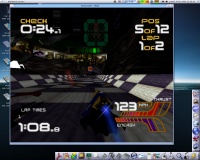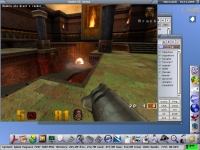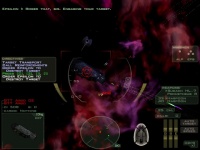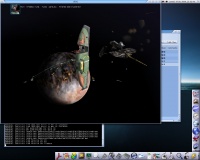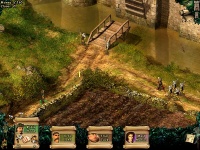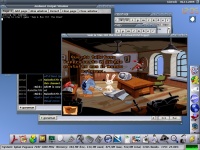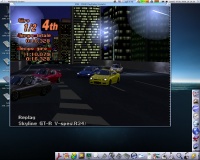Difference between revisions of "Games"
From MorphOS Library
(Aesthetic changes (reintroduced italic and liks), general content revision, added some new games (HomeWorld, Wesnoth, Warzone2100), updated VGP2 and FPSE content. Reintroduced and updated screenshots.) |
|||
| (One intermediate revision by one other user not shown) | |||
| Line 1: | Line 1: | ||
| − | [[File:VGP2HD_000.jpg|200px|thumb|left|Virtual Grand Prix 2]]One of the most notable games available for MorphOS is definitively ''Virtual Grand Prix 2'', published by Alassoft. It is a very realistic Formula 1 simulation (probably one of the most realistic for any platform), with nice 3D accelerated graphics, and the mandatory support for analog input devices, that in MorphOS is available thanks to the ''Poseidon'' USB stack and the new ''lowlevel.library''. The MorphOS version has been released shortly after the Mac and Windows ones, due to the Amiga roots of the main programmer Paolo Cattani. Notably, the MorphOS version is completely free. The game includes most of the true circuits, very nicely realised, and highly recognizable. Those not included can be found as additional packages created by users on the net. The game is quite fast and playable also on low end machines, including the 400MHz Efika with just 128MB of RAM. Moreover, the game was conceived with the maximum freedom to customize the graphics and this led to the creation of [http://www.siniscope.com/vgphd/home.html higher quality textures and more detailed circuits] that can be used in the MorphOS version as well. As a consequence this game is at the same time enjoyable on the lowest end machines and yet can be one of the most graphically advanced available on MorphOS. | + | [[File:VGP2HD_000.jpg|200px|thumb|left|Virtual Grand Prix 2 with HD textures]]One of the most notable games available for MorphOS is definitively ''Virtual Grand Prix 2'', published by Alassoft. It is a very realistic Formula 1 simulation (probably one of the most realistic for any platform), with nice 3D accelerated graphics, and the mandatory support for analog input devices, that in MorphOS is available thanks to the ''Poseidon'' USB stack and the new ''lowlevel.library''. The MorphOS version has been released shortly after the Mac and Windows ones, due to the Amiga roots of the main programmer Paolo Cattani. Notably, the MorphOS version is completely free. The game includes most of the true circuits, very nicely realised, and highly recognizable. Those not included can be found as additional packages created by users on the net. The game is quite fast and playable also on low end machines, including the 400MHz Efika with just 128MB of RAM. Moreover, the game was conceived with the maximum freedom to customize the graphics and this led to the creation of [http://www.siniscope.com/vgphd/home.html higher quality textures and more detailed circuits] that can be used in the MorphOS version as well. As a consequence this game is at the same time enjoyable on the lowest end machines and yet can be one of the most graphically advanced available on MorphOS. |
| Line 10: | Line 10: | ||
| − | [[File:freespace2.jpg|200px|thumb|left|Icculus' Freespace 2]][[File:HomeWorld_000.jpg|200px|thumb|right|HomeWorld port]]Other open source projects ported include the icculus.org games ''Freespace 1'' and ''2'' (that of course need the original versions to be fully operational), and games like ''NeverBall'' and the 3D pool game ''FooBillard''. ''Open Transport Tycoon Deluxe'', the open source reimplementation of Microprose's ''Transport Tycoon Deluxe'', is available, too. The MorphOS version (that, as well as all the other versions, needs the original game files to run) is synchronised with the official releases. This means that it is available directly from the project home page, since MorphOS support was inserted into the main source tree. ''Open Transport Tycoon Deluxe'' makes use of the ''PowerSDL.library'' to run. This library (whose special features are described in the section dedicated to [[MorphOS | + | [[File:freespace2.jpg|200px|thumb|left|Icculus' Freespace 2]][[File:HomeWorld_000.jpg|200px|thumb|right|HomeWorld port]]Other open source projects ported include the icculus.org games ''Freespace 1'' and ''2'' (that of course need the original versions to be fully operational), and games like ''NeverBall/NeverPutt'' and the 3D pool game ''FooBillard''. ''Open Transport Tycoon Deluxe'', the open source reimplementation of Microprose's ''Transport Tycoon Deluxe'', is available, too. The MorphOS version (that, as well as all the other versions, needs the original game files to run) is synchronised with the official releases. This means that it is available directly from the project home page, since MorphOS support was inserted into the main source tree. ''Open Transport Tycoon Deluxe'' makes use of the ''PowerSDL.library'' to run. This library (whose special features are described in the section dedicated to [[MorphOS key applications]]) facilitated already the porting of dozens of free and open source SDL games to MorphOS. A recent addition to this list of ports is the space real strategy game called ''HomeWorld'', that is probably the first game requiring at least MorphOS 2.1. Also in this case the user needs the original PC version to be able to play this game on his MorphOS system. Other open source real time strategy games are available, notably ''Warzone 2100'', while fans of turn based strategic games have the chance to get some hours of fun with the famous ''Battle for Wesnoth''. |
Latest revision as of 08:56, 20 December 2009
One of the most notable games available for MorphOS is definitively Virtual Grand Prix 2, published by Alassoft. It is a very realistic Formula 1 simulation (probably one of the most realistic for any platform), with nice 3D accelerated graphics, and the mandatory support for analog input devices, that in MorphOS is available thanks to the Poseidon USB stack and the new lowlevel.library. The MorphOS version has been released shortly after the Mac and Windows ones, due to the Amiga roots of the main programmer Paolo Cattani. Notably, the MorphOS version is completely free. The game includes most of the true circuits, very nicely realised, and highly recognizable. Those not included can be found as additional packages created by users on the net. The game is quite fast and playable also on low end machines, including the 400MHz Efika with just 128MB of RAM. Moreover, the game was conceived with the maximum freedom to customize the graphics and this led to the creation of higher quality textures and more detailed circuits that can be used in the MorphOS version as well. As a consequence this game is at the same time enjoyable on the lowest end machines and yet can be one of the most graphically advanced available on MorphOS.
Speaking of first person shooters, also Cube, AlephOne and the freeware game Warsow have been released. Warsow is probably graphically the most complex project ever ported to MorphOS (even though it is based on the old Quake II engine), and in fact might not run at a decent speed on a G3 CPU with Voodoo graphics. But it is also one mean to show that better hardware does not sit unused with MorphOS.

